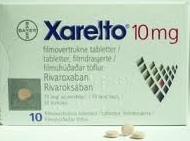According to recent research, the new blood thinners Xarelto and Pradaxa are no safer than warfarin when it comes to bleeding and complications like heart attacks and strokes.
 Researchers found no difference in the risk of bleeding events or arterial thromboembolism events between any of the three groups for the first 90 days of use.
Researchers found no difference in the risk of bleeding events or arterial thromboembolism events between any of the three groups for the first 90 days of use.
Medical experts are concerned about the new-generation anticoagulants, as they do not have a reversal agent, in the event of a serious or catastrophic bleeding, which can result in deadly results.
Medical Study: No Difference in Bleeding Side Effects
The latest research was published in the July edition of Circulation, here researchers found that there was no difference in the rate of bleeding events, strokes or heart attacks among patients using either Xarelto, Pradaxa or Coumadin (warfarin).
The researchers were investigating the safety and efficacy of the drugs during the early phases of treatment. Typically, patients first begin using the anticoagulant drugs as a preventative measure to prevent strokes caused by nonvalvular atrial fibrillation.
What are Xarelto and Pradaxa?
Pradaxa and Xarelto are two new blood thinners, known as novel oral anticoagulants (NOACs), which are touted as being superior and safer than warfarin.
But these drugs do not have a reversal agent, unlike warfarin, which means that when bleeding complications occur, doctors cannot stop them. The blood thinning effect of warfarin can be quickly stopped through the use of vitamin K and blood transfusions.
Blood Thinner Bleeding Risks
Pradaxa is made by Boehringer Ingelheim and is the first to hit the market of a new class of anticoagulants. Xarelto is made by Bayer and Janssen Pharmaceuticals, and is the second to be released and has rapidly gained the lion share of the market.
All blood thinners carry a risk of bleeding side effects, but Pradaxa and Xarelto injuries have become common as more patients are switched from warfarin to the new anticoagulants.
According to several recent medical studies, blood monitoring tests may help doctors identify patients at the greatest risk of bleeding.
Warfarin blood thinning effect on the blood is routinely measured by doctors on a monthly basis, and the makers of Pradaxa and Xarelto main selling point is that blood testing is not required with their drugs.
Boehringer Ingelheim Pradaxa Clinical Trial Data not shared with FDA
In July 2014, the BMJ reported that the Pradaxa’s Boehringer Ingelheim failed to provide the FDA with important clinical trial data. The data suggested that patients may benefit from regular blood monitoring to ensure the drug did not build up in their bloodstream, increasing the risk of bleeds.
According to research in the Journal of Cardiology in October 2014, researchers noted that Xarelto monitoring may have helped doctors understand the effects of the drug on a particular patient and their associated bleeding risk.
Pradaxa Bleeding Injury Lawsuits
Boehringer Ingelheim faced more than 4,000 Pradaxa lawsuits that allege inadequate warnings were provided about the lack of an available reversal agent for their medication.
The drug company agreed to settle the Pradaxa claims last year, with an average of $150,000 to former patients who developed injuries associated with uncontrollable bleeds.
Xarelto Bleeding Injury Lawsuits
Many Xarelto bleeding lawsuits are filed with similar allegations that inadequate warnings were provided about the lack of an approved reversal agent and that the companies should have never introduced the medication without an antidote.
Since December 2014, the cases have been centralized before Judge Fallon in the Eastern District of Louisiana as part of an MDL, or Multidistrict Litigation, to reduce duplicative discovery and to have the cases supervised by one judge. As of August, 17, there are over 1,200 federal lawsuits consolidated in the Eastern District of Louisiana.
There are several hundred more cases pending in various state courts nationwide, including Pennsylvania state court, where a Xarelto mass tort was established earlier in January.
 Dallas Fort Worth Injury Lawyer Blog
Dallas Fort Worth Injury Lawyer Blog

